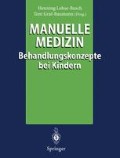Abstract
A secondary pathology consisting of muscular and autonomic disturbance of function is frequently superimposed upon the primary organic cerebral defect syndrome. A large part of the clinical symptomatology begins with these functional disturbances, and they are at least theoretically susceptible to manual medicine and its related procedures before any neuroplastic habituation has set in. Treatable dysfunctions are described in detail and their interactive relationship explained. From this, the concept of rehabilitation, together with its goals and limitations, is developed. The results attainable in this way are exemplified by 150 children with infantile cerebral palsy.
Zusammenfassung
Auf das primär hirnorganische Defektsyndrom pfropft sich regelhaft eine Sekundärpathologie von muskulären und vegetativen Funktionsstörungen auf. Ein großer Teil der klinischen Symptomatik beginnt mit diesen funktionellen Störungen, die vor ihrer neuroplastischen Verfestigung zumindest theoretisch der Manuellen Medizin und ihren verwandten Methoden zugänglich sind. Die behandelbaren Dysfunktionen werden detailliert beschrieben und in einen interaktiven Zusammenhang gestellt. Daraus wird die Rehabilitationskonzeption mit ihren Möglichkeiten und Grenzen entwickelt. Am Beispiel von 150 ICP-Kindern werden die mit dieser Konzeption erzielbaren Ergebnisse vorgestellt.
Access this chapter
Tax calculation will be finalised at checkout
Purchases are for personal use only
Preview
Unable to display preview. Download preview PDF.
Literatur
Arbuckle Beryl E (1995) The value of occupational and osteopathic manipulative therapy in the rehabilitation of the cerebral victim. J Am Osteopath Assoc 55: 4
Baumann JU (1989) Orthopädische Betreuung. In: Feldkamp M, Aufschnaiter D von, Baumann JU, Danielcik I, Goyke M (Hrsg) Krankengymnastische Behandlung der infantilen Zerebralparese. Pflaum, München, S 227–263
Bischoff HP (1988) Chirodiagnostische und chirotherapeutische Technik. Perimed, Erlangen
Brickenkamp R (Hrsg) (1975) Handbuch psychologischer und pädagogischer Tests. Hogrefe, Göttingen Toronto Zürich, S 161–162, 539 —540
Capone A, Bode R, Bubl R (1992) Reflexepilepsie bei taktilen Reizen. In: Köhler R, Keimer R (Hrsg) Aktuelle Neuropädiatrie 1991. Springer, Berlin Heidelberg New York, S 52–54
Feldkamp M (1989) Die zentrale Steuerung der Bewegung und ihre Störung bei Zerebralparesen. In: Feldkamp M, Aufschnaiter D von, Baumann JU, Danielcik I, Goyke M (Hrsg) Krankengymnastische Behandlung der infantilen Zerebralparese. Pflaum, München, S 24 — 40
Feldkamp M (1989) Sensorische Integrationsstörungen und ihre Behandlung nach Ayres. In: Feldkamp M, Aufschnaiter D von, Baumann JU, Danielcik I, Goyke M (Hrsg) Krankengymnastische Behandlung der infantilen Zerebralparese. Pflaum, München, S 199–204
Frisch H (1995) Programmierte Therapie am Bewegungsapparat: Chirotherapie. Springer, Berlin Heidelberg New York
Frymann VM, Carney RE, Sprigall P (1992) Effect of osteopathic medical management on neurological development in children. Osteopath Assoc 729–744
Greenman PE (1991) Principles of manipulation of the cervical spine. J Manual Med 6: 106–113
Hallet M, Cohen LG, Pascual-Leone A, Brasil-Neto L, Wassermann EM, Cammarota AN (1993) Plasticity of the human cortex. In: Thilmann AF, Burke DJ, Rymer WZ (eds) Spasticity: Mecha-nisms and management. Springer, Berlin Heidelberg New York, pp 67–81
Hömberg V (1993) Is rehabilitation effective in spastic syndromes. In: Thilmann AF, Burke DJ, Rymer WZ (eds) Spasticity: Mechanisms and management. Springer, Berlin Heidelberg 21. New York, pp 439–450
Himmelsheim H, Mauritz KH (1993) Neurophysiological mechanisms of spasticity. Modification by physiotherapy. In: Thilmann AF, Burke DJ, Rymer WZ (eds) Spasticity: Mechanisms and management. Springer, Berlin Heidel- 23. berg New York, pp 426–439
Janda V (1988) Muscles and cervicogenic pain syndromes. In: Grant R (ed) Physical therapy of the cervical and thoracic spine. Churchill Livingstone, New York Edinburgh London, pp 153 —166
Kalbe U (1993) Cerebral-Parese im Kindesalter. Fischer, Stuttgart New York, S 5–7, 51, 103
Karch D, Glauche-Hiegler A (1993) Neurophysiologische Grundlagen krankengymnastischer Behandlung bei infantilen Zerebralparesen. Ist ein Methodenstreit noch zeitgemäß? Krankengymnastik 45: 1211–1224
Lohse-Busch H, Döderlein L (1991) Rehabilitation psychomotorisch behinderter Kinder durch Atlastherapie. Poster. Kongreß der Deutschen Gesellschaft für Manuelle Medizin, Göttingen 1991
Lohse-Busch H, Brunner R, Baumann JU (1992) Einfluß der Atlastherapie auf kindliche Muskelkontrakturen bei spastisch zerebralen Bewegungsstörungen. In: Köhler R, Keimer R (Hrsg) Aktuelle Neuropädiatrie 1991. Springer, Berlin Heidelberg New York, S 158–160
Lohse-Busch H, Kraemer M (1994) Atlastherapie nach Arlen — heutiger Stand. Manuelle Med 32:153 —161
Lohse-Busch H (1994) Zwischenbilanz des Arbeitskreises Manuelle Medizin bei Kindern. Manuelle Med 32: 193–196
Mense S (1991) Neuroanatomische Grundlagen und physiologische Mechanismen der Massage. Phys Ther 12:412 — 420
Mense S (1993) Peripheral mechanisms of muscle nociception and local muscle pain. J Musculoskelet Pain 1:133 —170
Pain J (1991) Complications in manual medicine: a review of the literature. J Manual Med 6: 89–92
Seifert I (1981) Manualtherapeutische Aspekte der Htiftdysplasie — Untersuchungen an Neugeborenen. Beitr Orthop Traumatol 28: 161–163
Staubesand J, Li Y (1996) Zum Feinbau der Fascia cruris mit besonderer Berücksichtigung epi-und intrafaszialer Nerven. Manuelle Med 34 (im Druck)
Tomaschewski R (1983) Die Bedeutung der Wirbelsäulenfunktion in der Sagittalebene für die Pathogenese der idiopathischen Skoliose. Manuelle Med 31: 39–42
Editor information
Editors and Affiliations
Rights and permissions
Copyright information
© 1997 Springer-Verlag Berlin Heidelberg
About this chapter
Cite this chapter
Lohse-Busch, H., Kraemer, M., Reime, U. (1997). Möglichkeiten der Rehabilitation von zerebralparetisch bedingten Bewegungsstörungen bei Kindern mit den Mitteln der Manuellen Medizin. In: Lohse-Busch, H., Graf-Baumann, T. (eds) Manuelle Medizin. Springer, Berlin, Heidelberg. https://doi.org/10.1007/978-3-642-60504-8_3
Download citation
DOI: https://doi.org/10.1007/978-3-642-60504-8_3
Publisher Name: Springer, Berlin, Heidelberg
Print ISBN: 978-3-540-61516-3
Online ISBN: 978-3-642-60504-8
eBook Packages: Springer Book Archive

